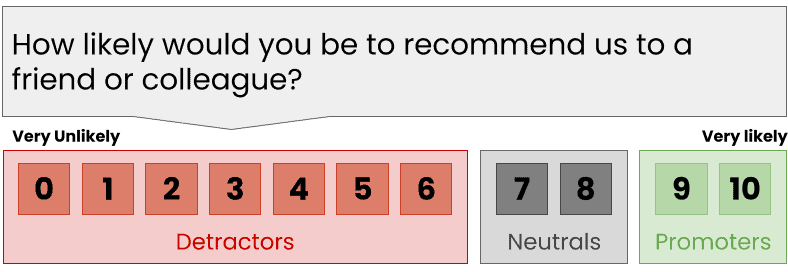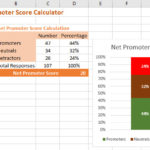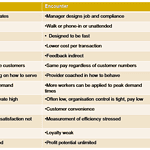Implementing a system that will automate the data collection and reporting elements of a Net Promoter Score (NPS®) process is an important step in integrating this key measure into the business.
Without effective automation of the task, it can often become too difficult to maintain and can fall by the wayside.
Key Takeaways: Automating Net Promoter Score
🚀 Benefits of Automating NPS Data Collection
- Enables timely survey delivery for Transactional NPS
- Facilitates consistent data collection and analysis
- Supports quick service recovery processes
🛠️ Key NPS Data Collection Automation Requirements
- Timely survey delivery
- Efficient reporting
- In-depth analysis capabilities
- Closed-loop process for service recovery
💻 NPS Data Collection Software Options
- General purpose survey tools
- In-house development
- Dedicated NPS software vendors
- CRM system extensions
But First What is Net Promoter Score
Before talking about automation – what is Net Promoter Score?
We have an in-depth guide for Net Promoter Score (NPS®), but in summary it is a metric that’s transforming how companies, both big and small, measure customer experience and predict future success.
At its core, Net Promoter Score is a straightforward yet powerful customer survey methodology. It centres around a single, critical question:

Customers respond on a scale from 0 (Very Unlikely) to 10 (Very Likely), and their answers paint a vivid picture of your company’s performance in their eyes.
Based on their responses, customers fall into three categories:
- Detractors (0-6): Unhappy customers who might harm your brand through negative word-of-mouth.
- Passives (7-8): Satisfied but unenthusiastic customers who could be swayed by competitive offerings.
- Promoters (9-10): Loyal enthusiasts who will keep buying and fuel growth through positive referrals.
Your Net Promoter Score is then calculated by subtracting the percentage of Detractors from the percentage of Promoters, resulting in a score between -100 and +100.

This simple calculation yields a powerful metric that correlates strongly with business growth. Companies with higher Net Promoter Scores compared to their competitors often enjoy more robust revenue growth, making NPS a key predictor of future business success.
What is a Transaction NPS survey?
The Net Promoter® technology was first published in 2004 and was initially developed as a Relationship metric for organisations. On a regular basis (perhaps every year or six months) organisations could perform an NPS survey to collect data on their overall (Relationship NPS) score.
However, one of the issues that became apparent was that although NPS is closely correlated to revenue, the Relationship NPS was difficult to convert into action. Just knowing that your score is X% or Y% is actually much less important than knowing how to move your score from X% to X+5%.
Transactional NPS was developed to measure the NPS of each customer transaction (or at least a sample of them) and gather information about what customers liked and disliked. By applying Transactional NPS at key service Moments of Truth (MoT), the organisation can implement process changes to improve its NPS for both the Transaction and the Relationship.
See this recent post for more information on Transactional Net Promoter Score.
Automating Transactional Net Promoter Score
A key stumbling block for many organisations is the need to automate the transaction survey process.
The annual or semi-annual Relationship NPS survey does not have a high need to be automated. The process can be well planned out in advance. Reporting and analysis can be performed at the end of data collection in an orderly, known way.
On the other hand, executing a survey every time a customer service Moment of Truth occurs can easily mean sending tens, hundreds or even thousands of personalised customer surveys each day. Each one is related to a different service transaction and needs to be reported and analysed in a specific but easy to action manner.
Automation Requirements Fall into 4 Areas
Timely survey delivery
Initiating a personalised survey in a timely manner after the customer has been through the Moment of Truth. This requirement includes the need to create contact rules so that customers do not get over surveyed if they transact on a frequent basis.
Timely Reporting
Reporting the feedback in a way that informs the client facing and management staff of the organisation. The organisation must be able to distribute the information to a wide variety of staff on a timely basis.
Enable Analysis
Reporting the feedback delivered in a way that allows easy analysis of the data and supports root cause analysis and hypothesis testing.
Closing the loop to enable service recovery
One of the key advantages of Transactional NPS is the ability to initiate timely Service Recovery processes. Any automation of the survey process must include a way for relevant company staff to be alerted dependant on the response that a customer provides.
Software Options for Automation
When examining the approaches for software automation of the Transaction NPS process there are really four options.
General Purpose Survey Tools
General purpose survey tools (e.g. Survey Monkey / Question Pro) provide quite good platforms for the automation of customer surveys. Many have ways to customise the reporting pages for basic Net Promoter Score.
On the down side they often lack the types of specialised reporting and work flow engines (specifically service recovery initiation) required for a successful Transactional NPS systems.
In-House Development
The second route that organisations can undertake is to develop a survey system in-house.
The major “con” to this approach is heavy design, development and testing costs involved with creating the necessary infrastructure (email engine, data interfaces, reporting platform, service recovery automation, etc) for one company to use. There is also the ongoing cost of maintaining and updating the system as requirements change.
Dedicated Software Vendors
There are a new generation of dedicated NPS (Relationship and Transaction) survey software companies, e.g. CustomerGauge Net Promoter software, that have been created to meet the market demand for NPS automation. In general these companies provide a Software as a Service (SaaS) approach, whereby the client accesses the software via the web, just like Gmail.
These purpose built applications provide all of the hooks and handles required for organisations to get up to speed quickly and effectively to deliver a Relationship or Transaction NPS process.
Often these applications also provide standard interfaces to CRM and web shopping cart applications such as Copper CRM, HubSpot CRM and Salesforce. This makes the data integration process quicker and simpler than other approaches.
Extension of the CRM System
The current level of sophistication in CRM systems means that organisations are often able to build on CRM system functionality to create an NPS process. This is especially true of marketing automation vendors, e.g. HubSpot, where the software is designed to provide event based marketing functionality.
Get the Business Leader's Guide to Net Promoter Score Download Here




